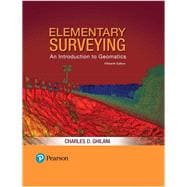For Surveying courses offered in Civil Engineering departments
Basic concepts and the latest advances and technology in modern surveying and geomatics
A highly readable bestseller, Elementary Surveying: An Introduction to Geomatics presents basic concepts and practical material in each of the areas fundamental to modern surveying (geomatics) practice. While introductory, its depth and breadth also make it ideal for self-study and preparation for licensing examinations. The 15th Edition is updated throughout to reflect the latest advances and technology. It includes QR codes linking to video instructions on solving specific problems, and more than 400 figures and illustrations, with numerous example problems to demonstrate computational procedures. With this new edition, Mastering™ Engineering is available for the first time
Also available with Pearson Mastering Engineering
Mastering™ Engineering is an online homework, tutorial, and assessment program designed to work with this text to engage students and improve results. Interactive, self-paced tutorials provide individualized coaching to help students stay on track. With a wide range of activities available, students can actively learn, understand, and retain even the most difficult concepts. The text and Mastering Engineering work together to guide students through engineering concepts with a multi-step approach to problems.
Note: You are purchasing a standalone product; MyLab™ & Mastering™ does not come packaged with this content. Students, if interested in purchasing this title with MyLab & Mastering, ask your instructor for the correct package ISBN and Course ID. Instructors, contact your Pearson representative for more information.
If you would like to purchase both the physical text and MyLab & Mastering, search for:
013465417X / 9780134654171 Elementary Surveying: An Introduction to Geomatics Plus Mastering Engineering with Pearson eText -- Access Card Package, 15/e
Package consists of:
- 0134604652 / 9780134604657 Elementary Surveying: An Introduction to Geomatics
- 0134650182 / 9780134650180 Mastering Engineering with Pearson eText -- Standalone Access Card -- for Elementary Surveying: An Introduction to Geomatics
Mastering Engineering should only be purchased when required by an instructor.








